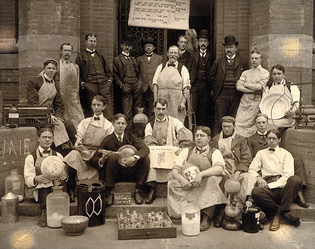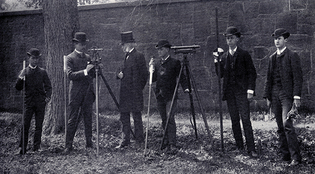 loading
loading
Old YaleA "Select Course" that helped reshape YaleThe three-year bachelor of philosophy degree foretold a changing curriculum. Judith Ann Schiff is chief research archivist at the Yale University Library.  Manuscripts and ArchivesScenes from the Sheffield School: in 1898, chemistry students assembled for a class portrait outside 51 Prospect. (One of them appears to be using a round-bottom flask as a banjo.) View full imageThese days, all Yale undergraduates work toward bachelor of arts or bachelor of science degrees. But from 1852 to 1931, the university granted another undergraduate degree—the bachelor of philosophy (PhB), a three-year course of study in the Sheffield Scientific School. Though the curriculum was sometimes looked down on by Yale College students, who pursued a more classical education, Sheffield and its PhB were to play a major role in reshaping Yale’s undergraduate education. The Sheffield School had its origins in the opening of a new Department of Philosophy and the Arts at Yale in 1846 (the same year Harvard opened its Lawrence Scientific School). Six years later, the department awarded the first PhB degrees to seven men who had completed the three-year applied science course. In 1854, the department became the Yale Scientific School, and in 1861, after it was endowed by railroad magnate Joseph Sheffield, it was rechristened the Sheffield Scientific School. In Yale parlance, the school would be known as “Sheff,” while Yale College was called “Ac” for “academic.” (Men who had earned a degree at Sheff were denoted, in Yale records, by an S after their graduation year.) The Sheffield School is remembered now mostly as the precursor of Yale’s School of Engineering, but its most important contribution to Yale may have been its Select Course, a three-year PhB program developed in 1860 that included mathematics, physical science, modern languages, literature, history, political economy, and commercial law. As Sheff’s last director (1898–1922), Russell H. Chittenden ’75S, ’80PhD, explained in a history of Sheff published in 1928:
Still, Chittenden wrote, not everyone was enthusiastic. “In 1860, however, the program of studies offered in the Select Course was startlingly new, while the complete absence of Latin and Greek made a contrast that aroused a feeling of distrust in many quarters.” Some of the Sheff courses deemed unacceptable in Yale College in the nineteenth century included the first modern English courses, taught by Thomas R. Lounsbury in the 1870s, and economics courses taught by General Francis Amasa Walker, who later became president of MIT.
 Manuscripts and ArchivesStudents in the 1870s practiced surveying while dressed to the nines. View full imageIn 1864, the course was reorganized by librarian, professor, and administrator Daniel Coit Gilman ’52, who later became president of, successively, the University of California, Johns Hopkins, and the Carnegie Institution. The Select Course grew rapidly in enrollment until it became the largest course in the school, overtaking its scientific and engineering tracks. Partly due to the popularity of the Select Course, in 1914 the students opting for Sheff overtook those choosing Ac, 326 to 293. Not long after that, alumni were motivated to spur a reorganization of the university; it took effect just after World War I. Undergrad Sheff was gradually merged into the college, which debuted the bachelor of science degree in 1922 and bachelor of engineering in 1933. In 1931, the last PhB degrees were awarded to 179 men, while 352 received the bachelor of arts degree and 197 the bachelor of science. The last alumni to graduate with an “S” for Sheffield after their undergraduate class year finished Yale in 1945. Meanwhile, a Yale College course of study came to look increasingly like Sheff’s Select Course: subjects like English, political science, and economics became the norm. The requirement of Latin for a Bachelor of Arts degree was dropped in 1931. Over eight decades, 8,679 PhBs had been earned at Yale. Among those who earned them were Alexander Wurts ’83S, inventor of the “lightning arrester,” an early surge protector; radio and long-distance telephone pioneer Lee De Forest ’96S; mining engineer John Hays Hammond ’76S; chemist and inventor Francis I. du Pont, ’95S; and Clarence King ’62S, first director of the US Geological Survey. Besides turning out leaders in engineering and technology, Sheff, through its Select Course, became the testing laboratory for Yale’s twentieth-century liberal arts courses. As Chittenden noted, it was the major influence in Yale’s successful reorganization from a classical college to a modern college and international university.
The comment period has expired.
|
|